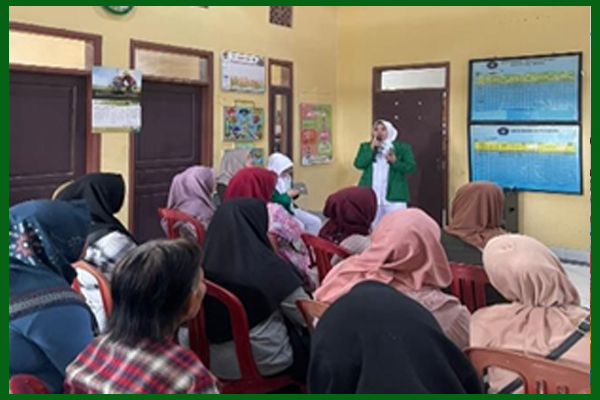PADI TUMBANG AT PAUD KANA" GROWTH SELF-MONITORING AT PAUD KANA AND PROVISION OF CATFISH NUGGETS TO PREVENT STUNTING IN PRESCHOOLERS
DOI:
https://doi.org/10.53067/ije2.v5i2.225Keywords:
Catfish Nuggets, Child Growth and DevelopmentAbstract
Toddlerhood is one of the critical phases for human growth and development. In the toddler period, a very rapid growth and development will affect the next life, and the continuity of growth and development of toddlers is affected by nutritional status. The nutritional status of toddlers is the nutritional condition of children aged 0-59 months determined by anthropometric methods, based on the index of Body Weight according to Age (BB / U), and Body Weight according to Height (BB / TB) (Izwardy, 2019).
This community service activity aims to exemplify to parents how to meet nutritional needs, one of which is by giving catfish nuggets, and how to "fall rice in paud kana" self-monitoring of growth and development in paud kana. This activity was carried out at PAUD Kana in West Bandung and involved children, parents, and school stakeholders. Patin fish nuggets are made from natural ingredients such as catfish, eggs, panir flour, pepper, onion, salt, and sugar, and are rich in protein to support children's health and growth. Nutrition education and demonstration on making fish nuggets were also provided to parents. The results of the activity showed that catfish nuggets not only attracted children, but also effectively increased their appetite. Through the nutrition education session and demonstration of making catfish nuggets, parents gained essential insights on providing healthy and nutritious food. This activity provides a practical solution to the problem of feeding difficulties in children and motivates families to adopt healthier eating habits. Catfish nuggets are an effective and easy-to-implement alternative to increase the appetite of toddlers, and support their optimal growth and development.
Downloads
References
Achadi, Endang L, et al. 2020. Stunting Prevention: The Importance of the Role of 1000 Days: First 1000 Days of Life. Depok: PT RajaGrafindo Persada.
Central Bureau of Statistics (BPS). 2017. Contribution of Food Crops to Agricultural Sector GDP in 2010-2016. Central Bureau of Statistics. Jakarta.
Badarudin, M. I. (2020). Processing Tenggiri Fish Meatballs (Scomberomorus Comersonni) with Tapioca Flour Concentration Based on Organoleptic Test. Journal of Fisheries and Marine Research, 1(2), 83-93. Retrieved from https://www.ejournal.umsorong.ac.id/index.php/jrpk/article/view/512
Beal, T. et al. (2018). "A review of child stunting determinants in Indonesia," Maternal and Child Nutrition, 14(4), pp. 1-10. doi: 10.1111/mcn. 12617.
Izwardy D. Integration of Sanitation and Nutrition for Stunting Prevention. Jakarta: Ministry of Health; 2018
Ramdhani, A., Handayani, H. and Setiawan, A. 2021. The Relationship between Maternal Knowledge and the Incidence of Stunting," Proceedings of the National Seminar LPPM UMP. 2(0), 28-35. https://semnaslppm.ump.ac.id/index.php/semnaslppm/article/view/122
Mustia (2018). Chemical properties of tapioca flour. 8th print. Yayasan Pembina Faculty of Forestry. Gajah Mada University. Yogyakarta.
Else Nutrition, 2023. Infant and Toddler Carbohydrate Needs. https://elsenutrition.com/a/resources/nutrition/infant-and-toddler-carbohydrateneeds.

Downloads
Published
How to Cite
Issue
Section
License
Copyright (c) 2025 Yenny Aulya, Lilis Lestari, Erni Setiawati, Diah Pipit Mardiani, Gita Rahmawati, Hilda Gustini, Deti Jubaeti, Alifah Nurfatin

This work is licensed under a Creative Commons Attribution-NonCommercial-ShareAlike 4.0 International License.















